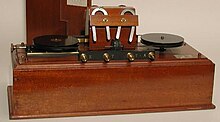Magnetic detector
The magnetic detector was one of the first devices that made it possible to receive wireless radio signals through headphones . Although not quite as sensitive as other detectors at the time, magnetic detectors were preferred on ships because of their reliability .
history
When Guglielmo Marconi in 1902 experiments on transatlantic communications conducted, he noted that the previously used Coherer for receiving the very weak signals are too insensitive and too unreliable and looked for better systems. The magnetic detector was also part of the radio equipment of the RMS Titanic and its sister ships.
function
An endless band of iron runs, similar to a tape, past the poles of permanent magnets and is thereby magnetized. At the same time, the high-frequency current from the receiving antenna acts on the tape, demagnetizing it more or less depending on its amplitude. This modulates the remaining magnetization with the amplitude of the RF signal. Then the magnetically low-frequency written tape is guided past a pickup winding, the output voltage of which is fed to headphones, making the modulation of the received signal audible.
Web links
- The recipient of the Titanic on schmegel.eu
